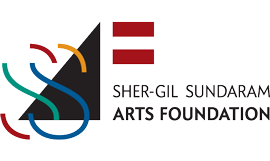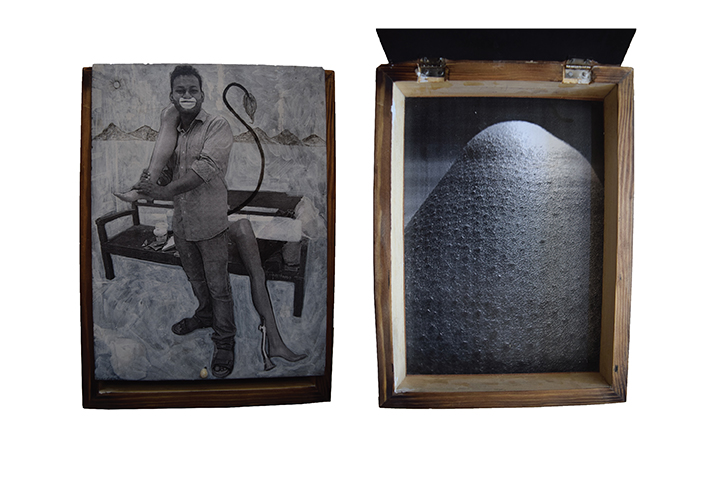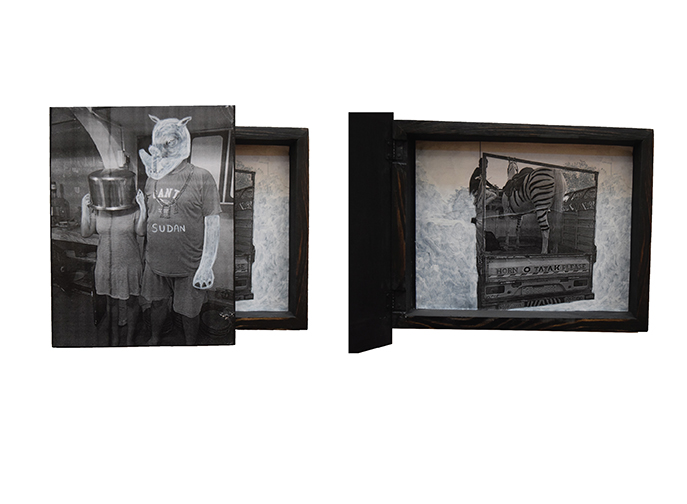Grant Recipient
KOMAL MISTRI
Title of the Project
BETWEEN THE LINES
Artist Statement
A photograph deals with identity and space. My work uses altered and/or constructed imagery assisted with found objects that resonate in the grey areas of memory, identity and space. I primarily relate with the identities of a woman in a domestic space, where she constantly struggles to alter her personalities according to her responsibilities, excluding her right to a personal space in that tiring process. Thus as an exposition of my own mind, I create boxes or enclosed spaces of deconstructed photographs and objects from my memory. The camera provides me with a perspective or the lens or a selective point of view to portray fragments that best render my personal existential crisis. The photograph gives an illusion of that challenging existence in the exterior and the interior creates a punctum.
The project started with an intention to search for a pseudo space that otherwise was not attainable physically. Experimenting with enclosure and the idea of creating a private space led to the formation of boxes and the use of archival materials as a repository of memories. These are a manifestation of the personal into the public sphere through the conscious alteration of photographic images and construction of enclosed space. My body of work provides an imagery of the otherwise unknown or overlooked emotion and identity of a woman through her memories. It has now gradually grown into an endeavour for developing visuals to show a collective consciousness of the female entity independent of her relation to her responsibilities.
The manifestation of the mentioned concepts takes an immense amount of psychological effort as it is difficult to portray the private and the personal onto a public sphere. The photographs that I take or the subjects that I chose to portray in them adhere to my personal sphere – mostly members of my own family and it is a constant struggle to open them up to a public viewership. But for me it is an archive of my psyche, of my unattended identity and an unattained space – all of which are constantly overlooked and in dire need of an aperture.
Currently I am building up enclosed spaces using easily available material and digital photographs with intervention and alteration with ink and charcoal. They are at present in a nascent intuitive stage forming a cluster of space, memory, emotion and identity. In the future I would like to develop it into a more sorted and concise pattern of work which will better convey my inner psyche to the viewers in a better way. The grant will be helpful for the development of the project in multiple ways – it will provide me with better material and tools for smarter and precise execution along with a chance to experiment more with the notions and methods of constructed photography and its multiple ways of printing that might suit my visuals in a more adept way.
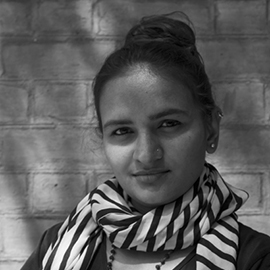
Based in Vadodara, Gujarat, Komal Mistri received a Post-Diploma in Painting from the Faculty of Fine Arts, Maharaja Sayajirao University, Vadodara and a Diploma in Painting from the Sheth C.N. College of Fine Arts, Ahmedabad. She is the recipient of the Nasreen Mohamedi Scholarship in 2018. Komal has participated in residencies at the Kanoria Centre, Ahmedabad; Feudo Maccari, Italy and the Robyn Beeche residency at Kriti Gallery, Benaras. She has participated in group exhibitions in India and abroad.
Jury
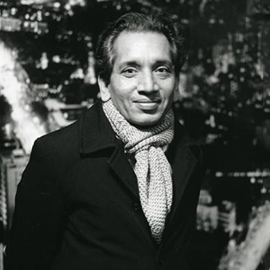
Deepak Ananth is an art historian and independent curator based in Paris. He was educated at the Universities of Bombay (St. Xavier’s College) and London (The Courtauld Institute of Art). He teaches the history of modern and contemporary art at the Ecole Supérieure d’Arts et Médias in Caen, Normandy.
He has written on a range of modern and contemporary European and Indian artists, mostly for museum publications. These include essays on Henri Matisse, Pablo Picasso, Édouard Vuillard, Pierre Bonnard, Howard Hodgkin, Sarkis Zabunyan, Anish Kapoor, Amrita Sher-Gil, Nasreen Mohamedi, Mrinalini Mukherjee, Umrao Singh Sher-Gil, Raghubir Singh, Dayanita Singh, Dileep Prakash among others. His essays have been published in catalogues accompanying monographic or thematic exhibitions at Museé national d’art moderne, le Centre Pompidou, Paris, Haus der Kunst, Munich, Tate Modern, London, Mori Museum, Tokyo, IVAM, Valencia, the Nationalgalerie, Berlin and The Metropolitan Museum of Art, New York. His monograph on the painter Arpita Singh was published in 2015.
His curatorial projects include exhibitions of contemporary French art, 19th century French painting, Surrealist photography, the drawings of Roland Barthes, the place of India in the Western imagination (Indomania, Brussels, 2013) and numerous exhibitions of contemporary Indian art following Indian Summer (Paris, 2005). He curated the survey show of Vivan Sundaram, Disjunctures, at the Haus der Kunst, Munich in 2018.
Photo by Dayanita Singh
Travel grant supported by GALLERYSKE and PHOTOINK
![]()
![]()

Quentin Bajac (Jury Chair) Born in 1965, a graduate of the Institut d’Études Politiques de Paris and the Institut National du Patrimoine, Quentin Bajac became curator of photography at the Musée d’Orsay in 1995, before moving to the Pompidou Centre in 2003. He held the chair in the History of Photography at École du Louvre and in 2010 he was appointed Chief Curator of Photography at the Pompidou Centre. From 2013 to 2018, Quentin Bajac was Chief Curator of Photography at the Museum of Modern Art (MoMA) in New York. In March 2019 Bajac was appointed the Director of the Jeu De Paume in Paris.
He has curated numerous exhibitions on 19th century and contemporary photography, including A World of Its Own: Photographic Practices in the Studio (2014), Scenes for a New Heritage: Contemporary Art from the Collection (2015) and most recently, Stephen Shore (2018). He was co-curator of the exhibition Being Modern: MoMA in Paris, at Fondation Louis Vuitton (2017).
Quentin Bajac has authored many books including Parr by Parr: Quentin Bajac meets Martin Parr (2010), Brassaï, Paris Nocturne with Sylvie Aubenas (2013) and Robert Doisneau: Pêcheur d’images (2012). He is also the author of a three-volume history of photography (Découvertes Gallimard, 2000-2010). He has written articles on photographers and artists who used photography such as Alexander Calder, Man Ray, Lucien Hervé, Henri Cartier-Bresson, Luigi Ghirri, Karen Knorr, Mimmo Jodice, Lise Sarfati, Hiroshi Sugimoto and Luc Delahaye.
Travel grant for the jury chair is supported by Ambassade de France en Inde and Institut Français, India
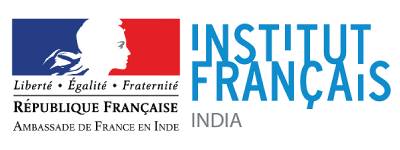
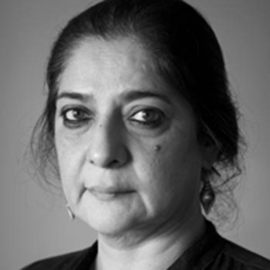
Born in 1958, Sheba Chhachhi’s lens-based works investigate contemporary questions about gender, the body, the city, cultural memory and eco-philosophy, through intimate, sensorial encounters. Chhachhi began as an activist and photographer, documenting the women’s movement in India. By the 1990s, she moved to creating collaborative staged photographs, eventually turning to large multimedia installations. Her works retrieve marginal worlds: of women, mendicants, forgotten forms of labour, and often draw on pre-modern thought and visual histories, interweaving the mythic and the social. She experiments across the spectrum of durational mediums, creating immersive environments, which bring the contemplative into the political in both site-specific public art and independent works.
Chhachhi has exhibited widely in India, and internationally, her works are held in significant public and private collections, including Tate Modern (UK), Kiran Nadar Museum of Art, (Delhi), Bose Pacia (New York), Singapore Art Museum, Devi Art Foundation (Delhi) and National Gallery of Modern Art (India). Chhachhi has published writings, given talks and conducted workshops, research and projects relating to women, conflict, urban ecologies, visual culture and contemporary art practice in both institutional and non-formal contexts. She lives and works in New Delhi.
Announcement of Grantee: 7 March 2020

Jury Statement by Quentin Bajac (Chair)
The jury sat for two days, going through 41 applications – from places all over India, with a rather good balance between male and female photographers – these numbers showing the increasing reputation of the grant which is now it seems in its fifth edition very well regarded and established in the Indian photographic landscape.
The great diversity of the different portfolios and projects we reviewed reveals how constructed or staged photography is today a multifaceted notion, at the crossroad of many different approaches and practices and transcending the different genres of photography. The jury was very careful to take into account an expanded definition of staged or constructed photography one that, following the grant’s guidelines, does not put aside the more documentary projects that for most of them involved also, despite their documentary nature, a constructed dimension.
The jury decided to have two special mentions to two specific projects – the first is Ashutosh Shaktan, with his Ministry of Fear project, exploring through urban myths and fake news, the ambiguous nature of photography; the second one being Siva Sai Jeevanantham, for his Upside Down collaborative project with children, around the Indian education system. Even if in the end these two candidates were not awarded the grant, the members of the jury sincerely hope that the two projects will be able to emerge and take shape in the coming months or years.
The 2020 Umrao Singh Sher-Gil Grant for Photography is awarded to Komal Mistri for her Between the Lines project. Born in 1986, Komal Mistri is today based in Vadodara where she is a student in post diploma at The Maharaja Sayajiro Universiity. She was honoured in 2018 with the Nasreen Mohamedi Scholarship award and has participated in several group shows in Ahmedabad, Delhi, Jaipur and Vadodara.
Working with photography and additional materials, Komal Mistri’s work uses altered and constructed imagery assisted with founds objects to create a work dealing with issues of identity, space and memory. The enclosed spaces she conceives through photography resonate as explorations and expositions of her own mind – ‘archive of her psyche’ in her own words. Often making reference to her family and her own personal history, these intimate tableaux, open the artist’s personal sphere, inviting the viewer into her own private world.
The members of the jury were struck by the inner necessity of Komal Mistri’s project and thought that this work in progress was of all the work submitted this year, the one that will benefit the most from this year’s grant. Deeply rooted in an intimate experience, it is nevertheless a rich metaphorical exploration of the role of the woman in today’s Indian society – and especially the woman artist. More photo-based than purely photographic, it opens new directions not explored by the Umrao Singh Sher-Gil Grant in the previous years, most notably the physicality of the photographic image, and the relation of photography to other art forms from painting to sculpture or assemblage. The jury is very confident that the work is rich of future developments and that the grant will enable Komal Mistri to experiment in new and unpredicted ways with the photographic medium and the methods of constructed photography in her works to come.
